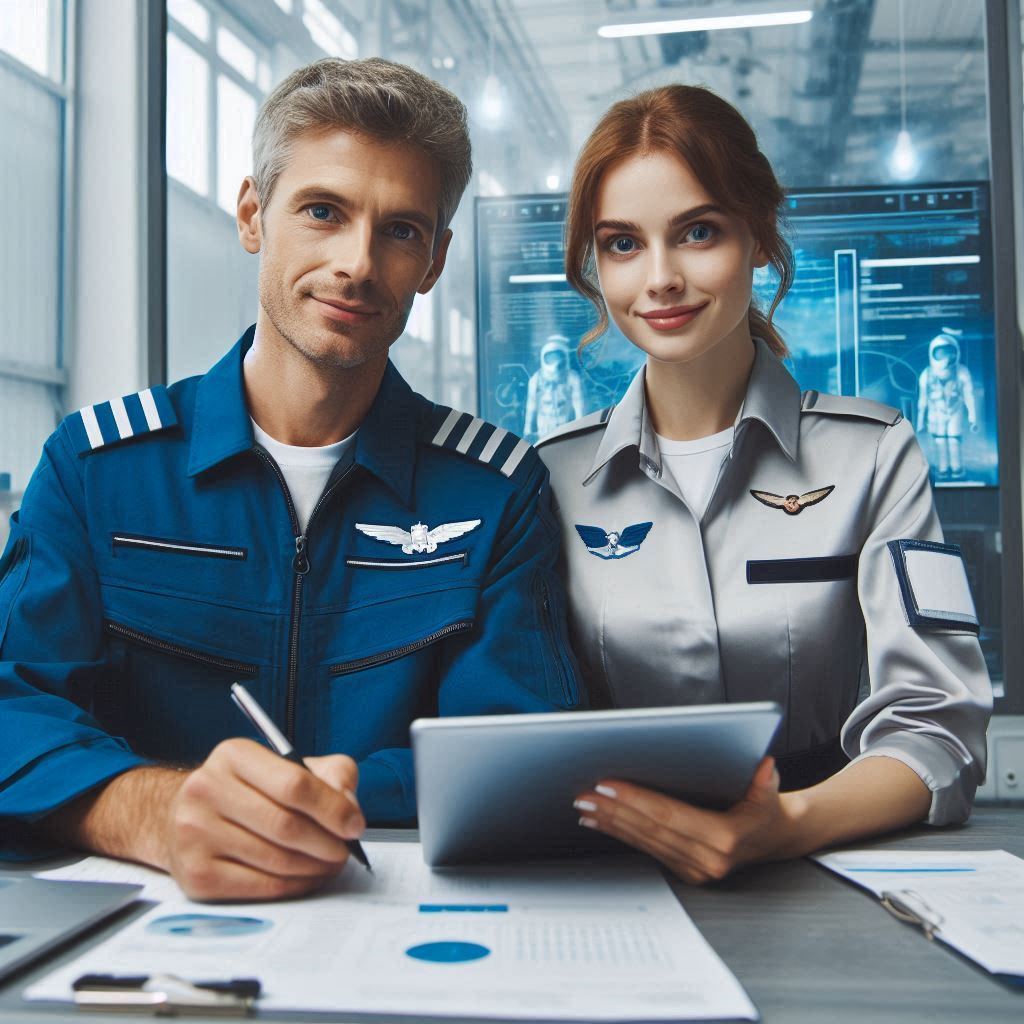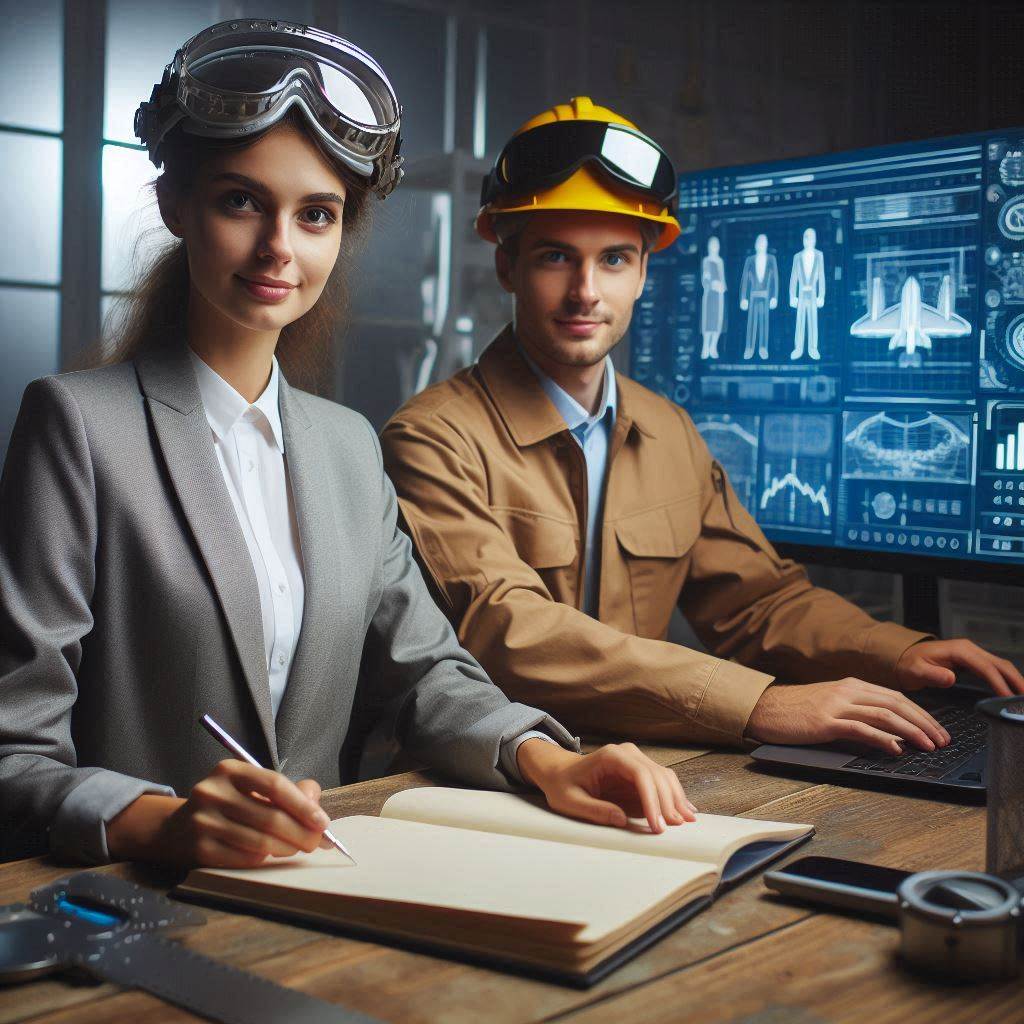Introduction
Aerospace engineering is a specialized branch of engineering focused on the design, development, testing, and maintenance of aircraft, spacecraft, and related systems and equipment.
This field encompasses a range of sub-disciplines, including aerodynamics, propulsion systems, avionics, and materials science, all aimed at advancing both atmospheric and space travel.
Aerospace engineers work on a variety of projects, from commercial airliners and military jets to satellites and spacecraft, playing a crucial role in shaping the future of transportation and exploration.
Despite its significance and complexity, aerospace engineering is often surrounded by misconceptions that can mislead those unfamiliar with the field.
In this blog post, we will address several common myths and misunderstandings about aerospace engineering.
We’ll clarify what aerospace engineers actually do, how their work impacts various industries, and the real challenges and opportunities within this dynamic field.
By debunking these misconceptions, we aim to provide a clearer understanding of what it means to work in aerospace engineering and the vital contributions engineers make to technology and society.
Misconception: All Aerospace Engineers Work for NASA
One common misconception about aerospace engineering is that all professionals in the field are employed by NASA.
While NASA is a prominent and influential employer in aerospace, it represents just one facet of the diverse career opportunities available to aerospace engineers.
Aerospace engineering is a broad discipline with applications across various sectors.
Engineers in this field can find employment in numerous industries, each offering unique and exciting roles:
Defense Industry
A significant number of aerospace engineers work in the defense sector, where they contribute to the development of military aircraft, missiles, and defense systems.
Companies like Lockheed Martin, Northrop Grumman, and Raytheon are major employers, engaging engineers in designing advanced fighter jets, unmanned aerial vehicles (UAVs), and sophisticated defense technology.
This sector focuses on enhancing national security and developing cutting-edge technologies for defense applications.
Commercial Aviation
In the commercial aviation industry, aerospace engineers work for major aircraft manufacturers such as Boeing and Airbus.
Their roles involve designing and testing commercial airliners, improving fuel efficiency, and developing new technologies for passenger aircraft.
Engineers in this sector may also work with airlines and maintenance organizations to ensure the safety and performance of aircraft.
Space Exploration Companies
The space industry has seen substantial growth beyond NASA, with private companies and commercial entities playing a significant role.
Companies like SpaceX, Blue Origin, and Virgin Galactic are at the forefront of space exploration and technology development.
Aerospace engineers at these companies work on spacecraft design, satellite deployment, and space tourism.
They contribute to missions ranging from launching satellites into orbit to developing technologies for potential manned missions to Mars.
Research and Development
Aerospace engineers also find opportunities in research and development (R&D) roles, both in academic settings and private research institutions.
They may work on innovative technologies, conduct experiments, and contribute to advancements in materials science, propulsion systems, and other areas critical to the aerospace field.
R&D positions often focus on pioneering new solutions and exploring emerging technologies.
Government and Regulatory Agencies
Beyond NASA, aerospace engineers can work for various government and regulatory agencies involved in aerospace and aviation.
The FAA and ESA employ engineers to ensure regulatory compliance, uphold safety standards, and develop new policies.
In general, NASA is a prestigious employer for aerospace engineers.
However, the field offers diverse career opportunities.
Aerospace engineers can work in defense, commercial aviation, space exploration, research and development, and government agencies.
Aerospace engineers can choose from diverse paths, each contributing to advancements in technology and addressing various challenges in the aerospace industry.
Misconception: Aerospace Engineering is Only About Building Rockets
A common misconception about aerospace engineering is that it is solely concerned with building rockets.
While rocketry is a significant aspect of the field, aerospace engineering encompasses a much broader range of disciplines and specialties.
The field is divided into two main branches: aeronautics and astronautics, each with its own set of focus areas and applications.
Aeronautics
Aeronautics refers to the study and design of aircraft that operate within Earth’s atmosphere.
This branch focuses on improving the performance, safety, and efficiency of various types of aircraft, including commercial airliners, military jets, and unmanned aerial vehicles (UAVs).
Key areas within aeronautics include
- Aircraft Design: Engineers work on designing new aircraft and improving existing models, addressing challenges related to aerodynamics, structural integrity, and materials.
- Avionics: This specialty involves the development and integration of electronic systems used in aircraft, such as navigation, communication, and control systems.
- Aircraft Systems: Engineers focus on the systems that ensure the proper functioning of aircraft, including propulsion, hydraulic, and environmental control systems.
Astronautics
Astronautics pertains to the study and design of spacecraft and technologies for operations beyond Earth’s atmosphere.
This branch includes the development of rockets, space probes, satellites, and spacecraft for human spaceflight.
Key areas within astronautics include
- Spacecraft Design: Engineers work on designing spacecraft for various missions, including satellites, space probes, and crewed vehicles. This involves addressing challenges related to space environments, propulsion, and life support systems.
- Rocket Propulsion: This specialty focuses on developing and improving rocket engines and propulsion systems used for launching spacecraft into orbit and beyond.
- Space Exploration Systems: Engineers develop technologies and systems for exploring other planets, moons, and celestial bodies, including landing systems, surface operations, and communication systems.
Specialties Within Aerospace Engineering
Aerospace engineering is a multifaceted field with numerous specialties, each addressing different aspects of aircraft and spacecraft development.
Some of these specialties include
- Aerodynamics: Engineers in this specialty study the behavior of air as it interacts with moving objects, such as aircraft and spacecraft. They work on optimizing the aerodynamic performance of designs to improve efficiency, stability, and control.
- Propulsion: This area focuses on developing and refining propulsion systems, including jet engines, rocket engines, and alternative propulsion technologies. Engineers work on increasing thrust, fuel efficiency, and reliability.
- Structures: Engineers specializing in structures work on the design and analysis of the physical components of aircraft and spacecraft, such as wings, fuselages, and spacecraft frames. They ensure that these structures can withstand the stresses and strains encountered during operation.
- Materials Science: Aerospace engineers in this specialty focus on developing and selecting materials that can withstand extreme conditions, such as high temperatures, pressures, and radiation. This includes working with advanced composites and alloys to enhance performance and durability.
- Systems Engineering: Systems engineers manage and integrate various subsystems within aircraft and spacecraft, ensuring that all components work together effectively. They oversee project management, risk assessment, and system validation.
Generally, aerospace engineering is not limited to building rockets but encompasses a wide range of disciplines and specialties.
From aeronautics to astronautics, the field involves diverse areas of focus, including aerodynamics, propulsion, structures, materials science, and systems engineering.
Each specialty plays a crucial role in advancing the capabilities of aircraft and spacecraft, addressing a variety of challenges, and contributing to the overall progress of the aerospace industry.
Misconception: Aerospace Engineering is Only for Geniuses
Challenging Yet Accessible to Passionate Students
Aerospace engineering is often perceived as an extremely challenging field, but it is accessible to students passionate about science and technology.
Many believe that only students with top grades or exceptional math skills can succeed.
While aerospace engineering does require strong analytical and problem-solving abilities, a genuine interest in the subject is equally important.
Passion for aerospace engineering can drive students to overcome challenges and achieve their goals.
Students with a fascination for space, aircraft, and advanced technologies often find aerospace engineering to be a rewarding field.
Educational programs in aerospace engineering build knowledge from the ground up.
These programs make the field accessible to dedicated learners.
Entry-level courses cover fundamental concepts in physics, mathematics, and engineering principles, providing a solid foundation for more advanced studies.
Aerospace engineering programs typically include hands-on projects and collaborative work, allowing students to apply theoretical knowledge to practical problems.
This experiential learning helps students develop critical skills and gain confidence in their abilities.
Students who actively engage in these projects often find themselves better prepared for complex challenges.
Importance of Hard Work and Dedication
Success in aerospace engineering hinges on hard work and dedication.
While the field presents challenges, perseverance is key to overcoming obstacles and achieving success.
Aerospace engineering involves rigorous coursework, demanding projects, and high standards, but commitment can lead to mastery of these requirements.
Students must be willing to invest time and effort into their studies.
Long hours of studying, problem-solving, and lab work are often necessary to grasp complex concepts.
Regular practice and persistence enable students to develop a deep understanding of aerospace principles and technologies.
In addition to academic rigor, involvement in extracurricular activities can enhance learning and career prospects.
Joining engineering clubs, participating in research projects, and seeking internships provide practical experience and networking opportunities.
These activities help students apply their knowledge in real-world settings and build valuable skills.
Dedication also extends beyond academic work. Aerospace engineers often face evolving technologies and industry demands.
Staying updated with the latest advancements and continuously improving skills are crucial for long-term success.
Lifelong learning and adaptability are essential traits for thriving in this dynamic field.
Aerospace engineering is challenging but accessible for students passionate about science and technology.
Strong enthusiasm makes the field approachable.
The key to success lies in hard work, dedication, and a willingness to engage deeply with the subject matter.
By embracing these principles, students can navigate the challenges of aerospace engineering and achieve their professional goals.
Transform Your Career Today
Unlock a personalized career strategy that drives real results. Get tailored advice and a roadmap designed just for you.
Start NowRead: Iconic US Buildings and the Architects Behind Them.
Misconception: Aerospace Engineering is Only for Men
A persistent misconception about aerospace engineering is that it is a field exclusively for men.
However, this view is increasingly outdated as the number of women entering and excelling in aerospace engineering continues to grow.
The field is becoming more inclusive, with numerous women making significant contributions and breaking barriers.
Increasing Representation of Women
The aerospace industry has seen a notable rise in female participation over recent years.
Organizations and initiatives are actively working to support and encourage women in aerospace engineering. Efforts include
- Educational Programs: Many educational institutions and organizations offer programs designed to attract and support women in aerospace engineering. These initiatives provide mentorship, scholarships, and networking opportunities to help women pursue and succeed in the field.
- Professional Organizations: Groups like the Society of Women Engineers (SWE) and Women in Aerospace (WIA) are dedicated to advancing women’s careers in engineering. They offer resources, support, and professional development opportunities tailored to women in the industry.
- Diversity and Inclusion Initiatives: Aerospace companies and organizations are increasingly recognizing the value of diversity and are implementing policies to create more inclusive workplaces. This includes promoting gender diversity in hiring, leadership, and career development.
Examples of Successful Female Aerospace Engineers
Several notable women have made remarkable contributions to aerospace engineering, demonstrating that the field is open to all talented individuals, regardless of gender
- Katherine Johnson: Katherine Johnson, a pioneering mathematician and aerospace engineer, worked for NASA. She calculated the trajectory for Alan Shepard’s space flight and the first moon landing mission.
- Mae Jemison: An engineer and physician, Mae Jemison became the first African-American woman to travel to space when she flew on the Space Shuttle Endeavour in 1992. She has since been a prominent advocate for science education and diversity in STEM fields.
- Gwynne Shotwell: As President and COO of SpaceX, Gwynne Shotwell has played a key role in advancing commercial space exploration. Under her leadership, SpaceX has achieved numerous milestones, including the successful launch and landing of reusable rockets.
- Peggy Whitson: An astronaut and biochemist, Peggy Whitson became the first female commander of the International Space Station (ISS) and has held multiple spaceflight records. Her contributions have significantly advanced human space exploration and research.
- Judy Resnik: An aerospace engineer and astronaut, Judy Resnik was the second American woman to fly in space. She was part of the Challenger mission, and her legacy continues to inspire future generations of engineers and astronauts.
In review, aerospace engineering is not limited to men.
The field is welcoming an increasing number of women who are making significant contributions and achieving notable successes.
Initiatives to support and encourage women, along with the achievements of pioneering female engineers, are helping to reshape perceptions and create a more inclusive and diverse aerospace industry.
Read: Post-Pandemic Design Trends: US Architects Adapt
Misconception: Aerospace Engineers Only Deal with Outer Space
A common misconception about aerospace engineering is that it is solely focused on outer space and space exploration.
While space missions are a significant and exciting aspect of the field, aerospace engineers work on a wide range of projects that extend well beyond outer space.
Their expertise impacts many areas of technology and infrastructure, affecting various aspects of daily life.
Diverse Areas of Focus
Aerospace engineering encompasses several areas of focus, each with its own set of applications and challenges
- Aircraft Design: Aerospace engineers play a crucial role in designing and improving aircraft used for commercial, military, and private purposes. This includes everything from large commercial airliners to smaller regional jets.
- Drones and Unmanned Aerial Vehicles (UAVs): The design and development of drones and UAVs are a growing area within aerospace engineering. These technologies are used for various applications, including surveillance, agriculture, delivery services, and scientific research.
- Satellites: This involves developing satellite systems that can operate effectively in space, including the design of satellite payloads, propulsion systems, and communication technologies.
Impact on Everyday Life
The work of aerospace engineers has a profound impact on everyday life, influencing many aspects of modern society
- Air Travel: Innovations such as quieter engines, more fuel-efficient designs, and advanced avionics systems have made air travel more accessible and reliable, connecting people across the globe.
- Communication Systems: Satellites play a crucial role in global communication networks, including television broadcasts, internet services, and mobile communications.
- Weather Forecasting: Weather satellites provide critical data for accurate weather forecasting and climate monitoring. Aerospace engineers develop and maintain these satellites, which help in predicting weather patterns, tracking storms, and studying environmental changes.
- Search and Rescue Operations: UAVs and advanced aircraft are increasingly used in search and rescue missions. Aerospace engineers contribute to the development of these technologies, improving their ability to locate and assist individuals in emergency situations.
- Military and Defense: Aerospace engineers work on developing advanced military aircraft, missiles, and defense systems, enhancing national security and tactical capabilities. These technologies play a role in defense strategies and ensuring safety.
In the end, aerospace engineering is not limited to outer space but spans a diverse range of applications that significantly impact everyday life.
Aerospace engineers design aircraft and drones, develop satellites, and improve communication systems.
They drive technological advancements that enhance air travel, communication, and weather forecasting.
Their work influences various aspects of modern society, demonstrating the breadth and importance of the field beyond just space exploration.
Read: Impact of Local Building Codes on US Architecture.

Misconception: Aerospace Engineering is a Dying Field
A common misconception about aerospace engineering is that it is a dying field, no longer relevant or essential in today’s technological landscape.
Aerospace engineering thrives as a dynamic field with growing demand and exciting advancements.
These developments shape the future of technology and exploration.
Growing Demand for Aerospace Engineers
The aerospace industry continues to experience significant growth, driven by advancements in technology and expanding opportunities across various sectors. Key factors contributing to the rising demand for aerospace engineers include:
- Increased Space Exploration: The renewed interest in space exploration, both by government agencies and private companies, has created numerous opportunities for aerospace engineers.
- Commercial Aviation Expansion: The commercial aviation sector is continually evolving, with airlines seeking more efficient, safer, and environmentally friendly aircraft.
- Military and Defense Innovations: The defense sector requires cutting-edge technology for advanced military aircraft, drones, and defense systems. Aerospace engineers play a crucial role in designing and developing these technologies to meet national security needs and address emerging threats.
- Emerging Technologies: Innovations such as electric and hybrid aircraft, autonomous flight systems, and advanced materials are creating new opportunities within the aerospace industry. Engineers with expertise in these areas are in high demand as the industry explores and implements these technologies.
Exciting Developments in Aerospace Technology
Aerospace engineering is at the forefront of several groundbreaking developments that highlight the field’s vitality and potential
- Reusable Rockets: The development of reusable rocket technology has revolutionized space travel by significantly reducing the cost of access to space. Companies like SpaceX and Blue Origin are leading the way in designing rockets that can be launched, landed, and reused multiple times.
- Supersonic and Hypersonic Flight: Projects aimed at developing faster aircraft for commercial and military applications are underway, with the potential to dramatically reduce travel times and enhance strategic capabilities.
- Electric and Hybrid Aircraft: The push for sustainable aviation has led to the development of electric and hybrid aircraft, which aim to reduce the environmental impact of air travel. These technologies are still in the early stages, but they hold promise for a more eco-friendly future in aviation.
- Space Tourism: The burgeoning space tourism industry represents a new frontier in aerospace engineering. Companies like Virgin Galactic and Blue Origin are working to make space travel accessible to private individuals, driving innovation in spacecraft design, life support systems, and safety protocols.
- Advanced Materials and Manufacturing: Aerospace engineers are exploring new materials and manufacturing techniques, such as 3D printing and advanced composites, to create lighter, stronger, and more efficient components.
Therefore, aerospace engineering is far from being a dying field.
The growing demand for aerospace engineers is fueled by advancements in space exploration, commercial aviation, military technology, and emerging technologies.
Exciting developments such as reusable rockets, supersonic flight, electric aircraft, and space tourism demonstrate the field’s ongoing relevance and potential.
Aerospace engineering remains a vibrant and forward-looking discipline, with numerous opportunities for innovation and career growth.
Read: How US Architects Adapt to Climate Change Concerns
Misconception: You Need a Ph.D. to Work in Aerospace Engineering
A common misconception about aerospace engineering is that a Ph.D. is required to pursue a career in the field.
Advanced degrees can open doors to specialized roles or research positions.
However, many viable career paths in aerospace engineering do not require a doctoral degree.
The field offers various educational pathways and emphasizes the importance of practical experience in addition to formal education.
Educational Paths in Aerospace Engineering
For those aspiring to work in aerospace engineering, there are several educational routes to consider:
- Bachelor’s Degree: The most common entry point into aerospace engineering is obtaining a bachelor’s degree in aerospace engineering, mechanical engineering, or a related field.
- Master’s Degree: For those looking to specialize further or pursue advanced technical roles, a master’s degree in aerospace engineering or a related field can be advantageous.
- Professional Certifications: In addition to formal degrees, various certifications can enhance an engineer’s qualifications. Certifications in project management, systems engineering, or specific software tools can be valuable and demonstrate specialized skills.
Importance of Hands-On Experience
In aerospace engineering, gaining practical, hands-on experience is crucial and often highly valued by employers. Here’s how internships and co-op programs play a key role:
Showcase Your Business Today
Reach thousands of readers actively exploring professional services. Publish your business profile and grow your audience now.
Publish Now- Internships: Internships provide students and recent graduates with real-world experience and exposure to the aerospace industry. They offer the opportunity to work on actual projects, learn from experienced professionals, and apply theoretical knowledge to practical challenges.
- Co-op Programs: Cooperative education (co-op) programs allow students to alternate between periods of academic study and full-time work in the industry. These programs provide extended, in-depth experience and often lead to job offers upon graduation.
- Research Projects: Research involves working on cutting-edge technologies and contributing to scientific studies. It also includes developing new solutions. This work benefits those interested in specialized or advanced roles.
Essentially, while a Ph.D.can be advantageous for certain research or academic positions in aerospace engineering, it is not a requirement for many career opportunities in the field.
A bachelor’s or master’s degree, along with hands-on experience from internships, co-op programs, and research projects, builds a strong foundation.
This combination paves the way for a successful career in aerospace engineering.
Practical experience is highly valued and can often be as important as formal education in securing and excelling in engineering roles.
Conclusion
We also debunked the notion that aerospace engineering is reserved for geniuses, emphasizing that passion, dedication, and hard work are far more important than innate brilliance.
The field is increasingly inclusive, with many women making significant contributions and breaking barriers, demonstrating that aerospace engineering is open to all talents and backgrounds.
Furthermore, we explored how aerospace engineering is far from a dying field.
The industry is thriving, driven by advancements such as reusable rockets, supersonic flight, and space tourism.
Lastly, while a Ph.D. is beneficial for some roles, a bachelor’s or master’s degree with internships can also build a strong career foundation.
With its diverse applications, ongoing innovations, and significant impact on everyday life, aerospace engineering offers a dynamic and fulfilling career path for those passionate about science and technology.
By challenging these myths and embracing the true scope of the field, you can discover a world of possibilities and contribute to the future of aerospace and beyond.
[E-Books for Sale]
The Big Book of 500 High-Paying Jobs in America: Unlock Your Earning Potential
$19.99 • 500 High-Paying Jobs • 330 pages
Explore 500 high-paying jobs in America and learn how to boost your career, earn more, and achieve success!
See All 500 High-Paying Jobs of this E-Book
1001 Professions Without a Degree: High-Paying American Jobs You Can Start Now
$19.99 • 1001 Professions Without a Degree • 174 pages
Discover 1001 high-paying jobs without a degree! Unlock career tips, skills, and success strategies for just $19.99!




